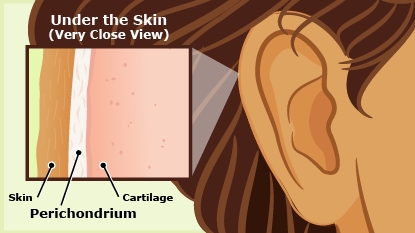Perichondritis is an infection of the perichondrium of the outer ear. The perichondrium is the layer of tissue between the skin and the cartilage. Kids with perichondritis (peh-ruh-kaan-DRY-tus) have redness, swelling, and pain of the outer ear. Sometimes there is a collection of pus, called an abscess.
Perichondritis needs to be treated with antibiotics right away. If it's not treated, the infection can spread to the cartilage of the ear and cause permanent changes in the shape of the outer ear.


Follow your health care provider's recommendations for:

Your child:

Your child:

What causes perichondritis? The infection is caused by bacteria (germs). The bacteria enter through an opening in the skin after ear piercing; an injury to the ear; or a burn, cut, or bug bite.
How is perichondritis treated? It is treated with antibiotics. Sometimes the antibiotics can be given by mouth, but if the infection is serious, the antibiotics need to be given into a vein (intravenously or IV). Some kids with perichondritis will also need surgery to take out pus or infected tissue.
What problems can happen from perichondritis? Perichondritis can spread to the cartilage of the ear. This can permanently damage the cartilage and change the way the outer ear looks. Also, perichondritis can spread to the blood and cause a serious blood infection called sepsis. Starting treatment with antibiotics as soon as perichondritis starts and taking the antibiotics as directed help prevent these problems.